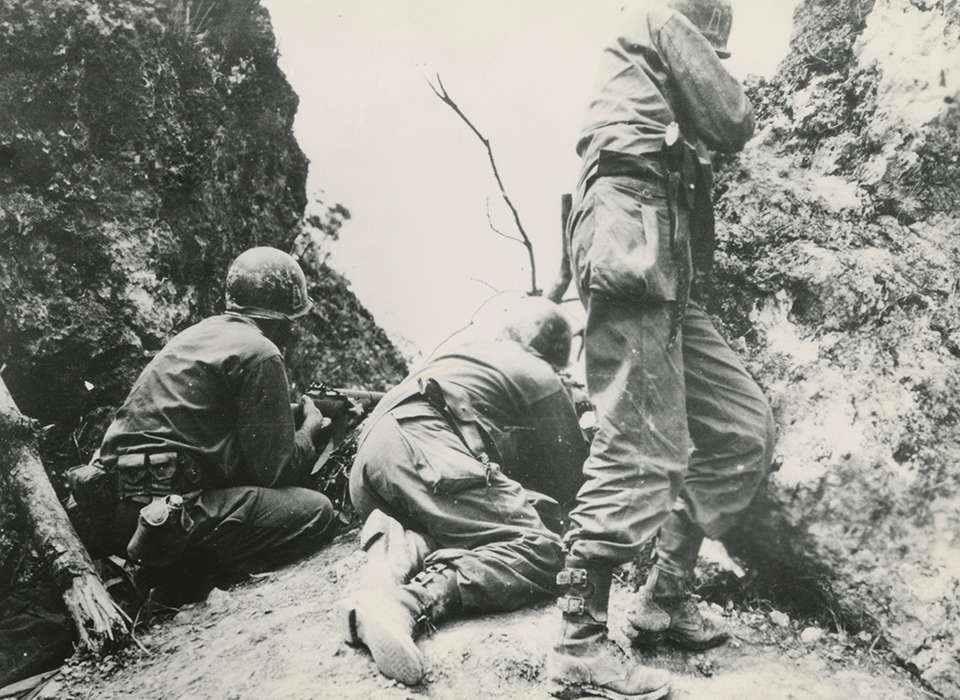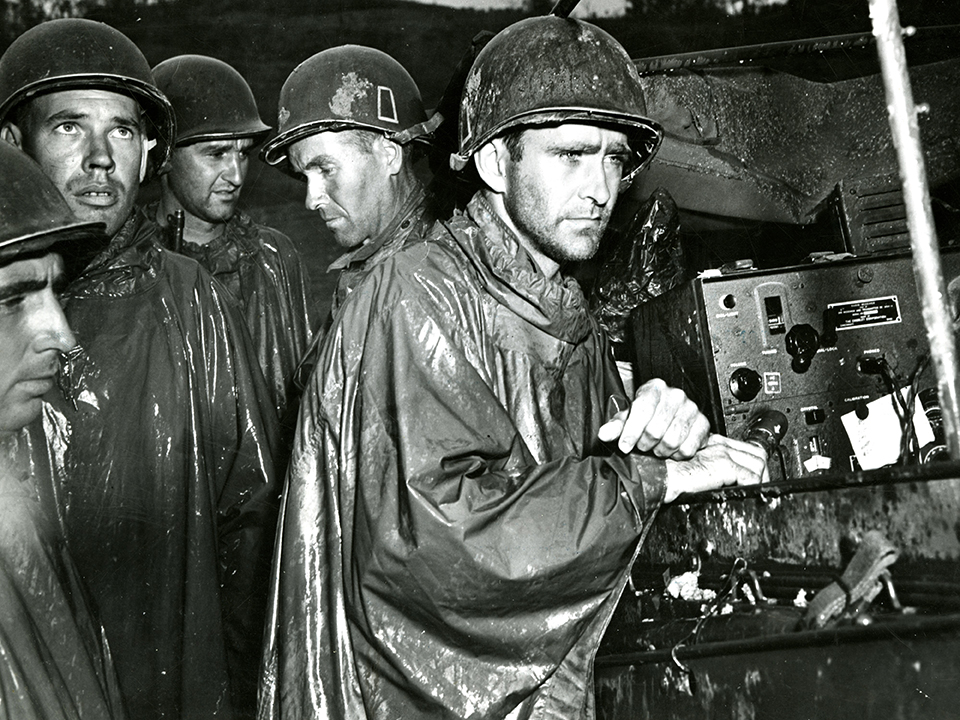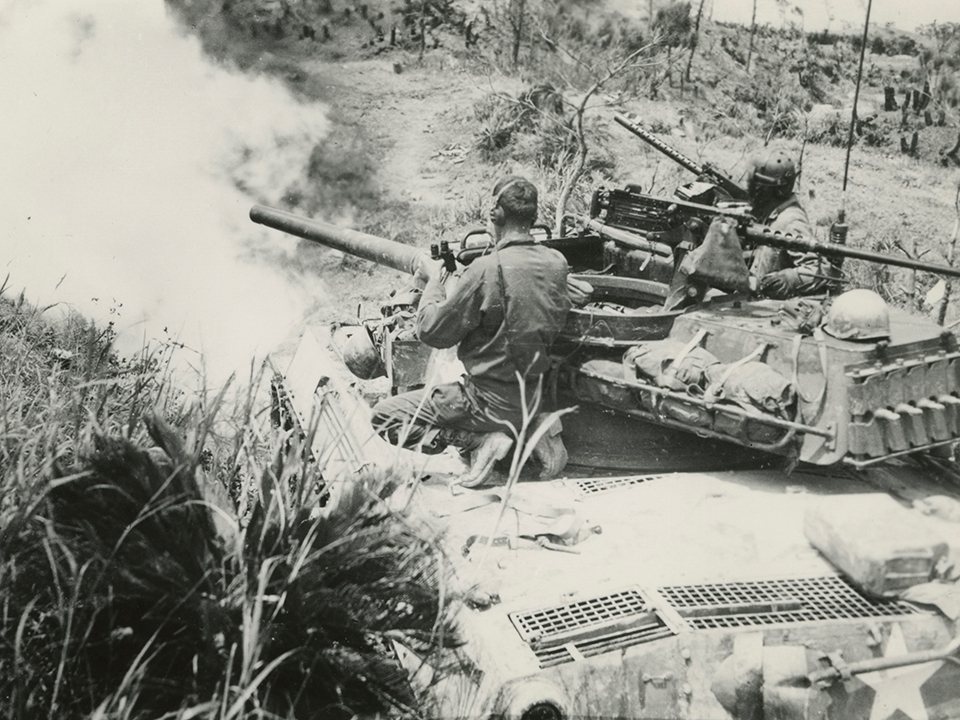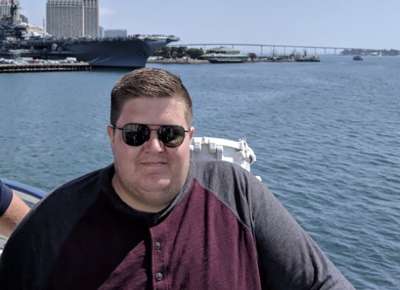Top Image: Soldiers from the 77th Infantry Division fight in the rugged terrain of southern Okinawa. US Army photograph. The National WWII Museum, Gift of Thomas J. Hanlon, 2013.495.1125
When word reached the miserable men of the US Army’s 77th Infantry Division on Okinawa that the Allied forces were victorious in Europe, they greeted the news with ambivalence. Over the previous month they had assaulted multiple islands west of the mainland, rode aboard a convoy for weeks as kamikazes tore into the ships, and most recently fought for a week on the southern front of Okinawa. Stubborn enemy resistance and the brutal nature of the fighting made clear that their war was far from over.
77th Infantry Division soldiers gather around a radio to listen to news of Germany’s surrender. US Army photograph. The National WWII Museum, Gift of Dylan Utley, 2012.019.208
The division joined the fighting on mainland Okinawa at the end of April 1945. Across the southern front, the Tenth Army was engaged in a series of bloody battles on the Shuri Line, the main Japanese positions on Okinawa. They were making little headway against a monotonous succession of countless ridges, hills, and ravines turned by the enemy into an imposing defensive network. The Americans paid dearly for each yard of ground as they pushed south toward the center of Japanese resistance at Shuri Castle. As a result, Tenth Army planners decided to launch a large-scale offensive to break the stalemate.
At the start of the offensive on May 11, what progress the Americans initially managed quickly slowed. Two of the 77th Division’s three regiments were soon mauled from constant fighting. The 305th Infantry was down to one-quarter its normal strength. The 306th Infantry was similarly exhausted. Relieving the latter on the morning of May 15, the 307th Infantry joined the line.
Desperate to speed up progress and alleviate losses, the 77th Division planned an audacious nighttime assault against the Shuri Line. In the early evening on May 16, commanding officer of Easy Company, 307th Infantry Regiment, 1st Lieutenant Theodore S. Bell, met with his platoon leaders to inform them the company would be joining a battalion assault the next day. The officers climbed to the top of a rocky outcropping to an observation post. In the dying light, they scanned the hundreds of yards of open expanse they would soon cross. Through the dusk’s haze the battalion’s distant objective barely came into view—Ishimmi Ridge, the heart of the inner Shuri defense line. Easy Company’s orders were to seize and hold the center of the 500-yard-long ridgeline, half-a-mile in front of friendly positions. Though he would not indicate it to his men, Bell had a sinking feeling they had little chance of surviving.
The Japanese were masters of nighttime attacks. By comparison, the Americans in the Pacific theater rarely ventured beyond their secure perimeters after nightfall. The 2nd Battalion would use these well-known habits to its advantage by launching an unexpected pre-dawn surprise attack. At 2:15 am, Easy Company awoke, a sobering start to Lieutenant Bell’s first wedding anniversary. Forty-five minutes later, 2nd Platoon led a single column 450 yards across rough terrain and down into the valley to the line of departure. They were joined there by troops who would augment their numbers—a heavy machine gun section from Company H and a reinforced rifle platoon from Company C of 1st Battalion. Company E moved out at 4:15, quietly swallowed up by the darkness and the 1,500-foot-wide valley floor.
Ishimmi Ridge was still 800 yards distant. In the inky blackness the officers oriented themselves using the light of US illumination flares lazily falling to earth. Their target was three or four scarred trees on the two highest points of the ridge. The 204 men moved with fixed bayonets as a coordinated mass, staying in the low areas and using the staccato rattling of machine guns and whirring artillery shells to mask their movements. When flares lit up the night sky, they froze. The GIs approached the ridgeline just as dawn was beginning to break, advancing farther in less than two hours than the division had over the previous week, all without firing a shot.
Climbing a steep rise at 5:05 am, the company discovered that the center of Ishimmi Ridge was only about 20 feet wide at the summit. Just beyond that the ground fell gradually to a tabletop expanse stretching 1,500 feet left to right. Directly ahead it pitched up into another ridge that led up to Shuri Castle. Eager to find cover before daylight, the platoons fanned out and took refuge wherever they could, some scratching fighting holes out of the coral and rock.
By 5:30 am, the Japanese faced the shocking realization that a brazen American night attack had penetrated the heart of their line. Murderous fire suddenly fell upon Easy Company. Machine guns searched for targets while mortars and artillery slammed into the hard ground. The GIs lay as flat as they could in their unfinished foxholes to escape the shrapnel. The morning light made clear what darkness had obscured. The attack was almost too successful—Company E was out ahead of the other assaulting companies and surrounded. Both flanks were taking accurate fire as the enemy poured out of caves and tunnels. Throughout the morning, the Japanese steadily winnowed the isolated unit. The attached heavy machine gun section was knocked out quickly. By 10:00 am, all but one of the mortars was destroyed and most of the crews killed or wounded. By noon, 50 percent of the 2nd Platoon was killed or wounded. At 6:00 pm there were few able-bodied survivors left in 3rd Platoon after fighting extended grenade duels and repulsing three enemy bayonet attacks. The attached platoon from Company C was also badly mauled. Some 30 of the 58 men were fresh replacements. Their undeniable courage when repelling several enemy counterattacks ultimately could not make up for their lack of experience.
Outnumbered and isolated, the GIs fought bravely. Lieutenant Robert F. Meiser, 2nd Platoon leader, reported that despite the hellish battlefield, the company’s discipline did not break:
"It seemed as if the men realized the danger of faltering and each and every man stuck to his allotted position, fighting back savagely while there remained a breath of life in his body. Wounded men insisted on being propped up, given a rifle and another chance to even the score with the enemy. Individual acts of heroism and sacrifice were witnessed continually and many probably went unseen."
The same enemy positions that had Lieutenant Bell’s men cut off also kept the other two companies from 2nd Battalion pinned down. The expansive valley floor Easy Company crossed before dawn was still under observation by the enemy with clear fields of fire from the surrounding hills and ridges. The regiment could not send reinforcements and the survivors on Ishimmi Ridge could not withdraw.
Company E’s predicament was eerily reminiscent of the Lost Battalion of World War I, also part of the 77th Division. Their only hope was to use the sole remaining radio of their original five to direct a protective blanket of steel. By midday, M18 Hellcat self-propelled guns in the rear skillfully hit pinpoint targets all around the encircled soldiers, striking so close that the explosions showered the infantrymen with rock. This accurate support was augmented by field artillery, heavy machine guns, and mortars, breaking up repeated Japanese bayonet charges. Lieutenant Bell realized the depleted company could not defend its original positions after the horrific casualties it had already suffered. He ordered the remainder of 2nd and 3rd Platoons to fall back to the command post, a pocket only 20 yards in diameter, for a final stand.
An M18 Hellcat of the 77th Division fires at enemy positions at Shuri. US Army photograph. The National WWII Museum, Gift of Thomas J. Hanlon, 2013.495.1125
Throughout the night, artillery, mortars, and explosives continued to pummel the exhausted troops. Out of water after an unusually hot day without a breeze, the men were low on rations as well. When a rescue unit attempted to reach them, a Japanese ambush decimated the force. Under the light of American flares, Easy Company’s exhausted survivors beat back numerous infiltration attempts by Japanese troops. Unable to sleep, they counted the long hours before dawn.
The enemy’s attacks on the second day steadily grew in ferocity. Snipers and machine guns persistently harassed the troops. Knee mortar barrages increased into a shocking crescendo. So did the nerve-wracking cries of the wounded as they suffered in the heat with no water, their wounds going untreated after Easy Company used all its medical supplies. Lieutenant Bell received word that even though his ranks were winnowed, they were to hold the ridge at all costs. The men resigned themselves to hopelessness. They would now ensure that the Japanese paid grievously to take back the positions. When an 80-man litter party made it to the company on the second night and evacuated the wounded in two and a half hours, spirits buoyed slightly. The limited supplies of water and ammunition brought by the litter party also steeled the exhausted survivors.
Dawn of the third day, May 19, brought a repeat of the preceding two. With seemingly inexhaustible supplies of men and ammunition, the Japanese onslaught continued. The ridge was constantly alive with the crackle of small arms and machine guns, thumping mortars, and crashing artillery rounds. Just before their radio finally went silent at noon from a drained battery, a message of hope came through to Lieutenant Bell: they would be relieved overnight if possible. Knowing their ordeal was almost at an end, time slowed to a crawl. Finally, the increasing sound of rifle fire to the rear signaled that friendly troops were on the way. By 10:00 pm, Company L of the 306th Infantry began appearing out of the darkness. By 3:00 am, the last of Easy Company walked away from the positions they had held for 70 hellish hours.
The group who made it back to the original line of departure were only a fraction of those who climbed Ishimmi Ridge. Easy Company was almost annihilated, from 129 men down to a mere 31. Of the 17 from the attached heavy weapons group, only four returned. The reinforced platoon from Company C was reduced from 58 to 13 men. Out of 204 soldiers on May 17 who crept across the open valley, 156 were casualties, the majority killed in action.
If the costs were weighty, so was the significance of what the lost company accomplished. Acting as the tip of a spear, their valor on Ishimmi Ridge cracked the center of the inner ring of the Shuri defenses that stretched from the west coast to the east, a line against which US forces were frustratingly stalled. Three days of nearly constant fighting killed hundreds of veteran enemy troops, diminishing a quickly draining reserve. The foothold that the men of Easy Company gained and stubbornly clung to also helped erode a key position in front of Shuri. American forces continued to aim directly at the heart of the enemy resistance on Okinawa. In a little over a week, in the face of unstoppable US attacks, the Japanese withdrew from their Shuri defenses. The supposedly invincible Shuri Castle had finally fallen to the Americans.
Adam Givens, PhD
Adam Givens is the DPAA Research Partner Fellow at The National WWII Museum and earned his PhD from Ohio University.
Cite this article:
MLA Citation:
APA Citation:
Chicago Style Citation:







![Max Fuchs, New York City cantor, sings as Rabbi Sydney [sic] Lefkowitz, Richmond, VA, conducts the first Jewish services from Germany.](/sites/default/files/styles/max_650x650/public/2025-10/image1.jpg)



